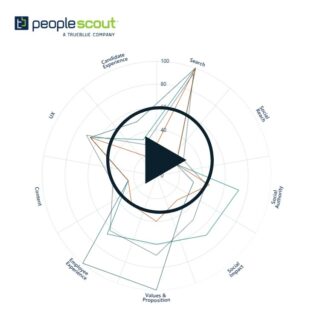While virtual reality (VR) is not new, it is gaining popularity in talent acquisition as a powerful tool for elevating the candidate experience. If used correctly, VR can help companies win talent by standing out from the content companies send to candidates. VR is also a strong tool to promote an employer’s brand.
VR allows users to experience their surroundings in an imaginary immersive environment. From flying on a broomstick at the Wizarding World of Harry Potter at Universal Studios to entering a haunted house simulation, virtual reality is a first-person, other-world experience. In recruiting, virtual reality gives candidates a look into real-world activities, virtually experiencing a day-in-the-life of a potential job while helping employers promote their brands in an uninterrupted way.
VR is usually a blanket term for any immersive virtual experience. However, other concepts related to VR add to the landscape of tools in production or now available. These technologies include 360-degree videos (e.g., home tours), computer-generated VR, augmented reality (e.g., wearing Google glass) and the further-out-there mixed reality technology (e.g., the real world and virtual world interact with one another). Mobile AR is also emerging; think the popularity of Pokemon Go. Mobile AR is predicted to one day potentially drive the majority of the growth of VR/AR. However, the 2014 VR market revenue was $62.1B and is expected to balloon to $310B by 2025.
Virtual Reality Applications in Talent Acquisition
VR is used in many different formats in talent acquisition. Career fairs are a popular example. Candidates use VR headsets to experience a first-hand look at what a day-in-the-life might look like before they pursue a position. The British Army used this tactic successfully, allowing candidates to virtually ride tanks in a simulated drill; as a result, the British Army saw its recruitment applications rise by 66 percent. Similarly, the U.S. Navy is also experimenting with virtual reality at career forums, where recruits can immerse themselves in virtual reality combat situations by acting as Navy Seals.
Deutsche Bahn also demonstrates different job roles using VR. Various simulation videos show candidates what it would be like to be a construction worker, a train conductor or work in various other roles. Deutsche Bahn reports that having candidates experience VR has increased the focus and volume of candidates applying.
Some VR applications have merged with gamification techniques. One example of this has been successfully measured by Jaguar. Jaguar developed a skills-based mixed-reality game to attract electronic and software engineers. Available as a mobile app, users engage willingly in a skills test when in-game. Those with interest in Jaguar and who exhibit high aptitude on these tests are green-lighted through the recruitment process.
When new workers join an organization, onboarding and training play a critical role in helping them assimilate faster and reduce turnover. Being trained in a more immersive environment using VR increases learning retention in a more present, focused state. It can also be fun. Kentucky Fried Chicken recently rolled out a program where new cooks are taught the Colonel’s famous Kentucky Fried Chicken recipe through a VR game.
Using Virtual Reality to Attract Candidates
Candidates have a blind spot when they apply to companies they do not know professionally. Part of the true picture of how an organization operates remains unknown, even after reading employer branding materials, social media posts and company-review websites like Glassdoor or Yelp!.
VR helps candidates feel more confident about accepting a role because they know more about how an employer operates. With VR, there is a deeper level of personalization and engagement that gives candidates a real-world look into their potential employer’s world. Similar to video, but in a more immersive way, VR creates an emotional connection.
Candidates who do not feel attached to a company’s mission, vision or brand also have the opportunity of self-selecting out of the process. If a candidate makes that decision, then possible costs associated with an in-person interview can be avoided.
One item to keep in mind when attracting candidates is that younger audiences are more closely drawn to VR than older audiences. Younger candidates are potentially more familiar with modern technologies than their older peers. If a company is looking to attract an older workforce, VR may not be the right path. Or, it should be supplemented with other tools, so more senior candidates are not discouraged from applying.
Getting Started with Virtual Reality
Today, most examples of talent acquisition applications of VR are organizations with the scale to run enterprise-wide programs or those with an RPO partner experienced in deploying new technology.
If you’re thinking about adding virtual reality efforts to your recruiting program, we recommend taking the following steps before getting started.
- Confirm your existing talent acquisition program is complete. Are your processes and candidate flow aligned? Do you have the right ecosystem in place for your entire talent acquisition process? Adding VR will help you measure if it differentiates your organization to new candidates. An optimized program will be flexible, allowing you to add VR where it is needed.
- Understand your target audience. The content you design needs to target a particular audience. You should already have persona-specific content related to your candidate journey. This targeting needs to come to life with VR too.
- Use VR in conjunction with other tools in the technology ecosystem. VR is a great way to promote your employer brand and attract candidates. Once interested, candidates still need to be assessed before moving on in the process. Consider doing this through on-line assessments, video interviewing or a combination of related strategies.
- Monitor the talent acquisition technology ecosystem market. VR is mature in the consumer world, but still in its infancy in the B2B world. As VR matures in talent acquisition, monitor similar and complementary technologies that may also be used in the future, such as augmented reality or mobile applications.
Virtual reality should be geared to the right audience as part of an overall recruitment program. Organizations should consider VR and track the growth of associated technologies to stay ahead of the competition.



